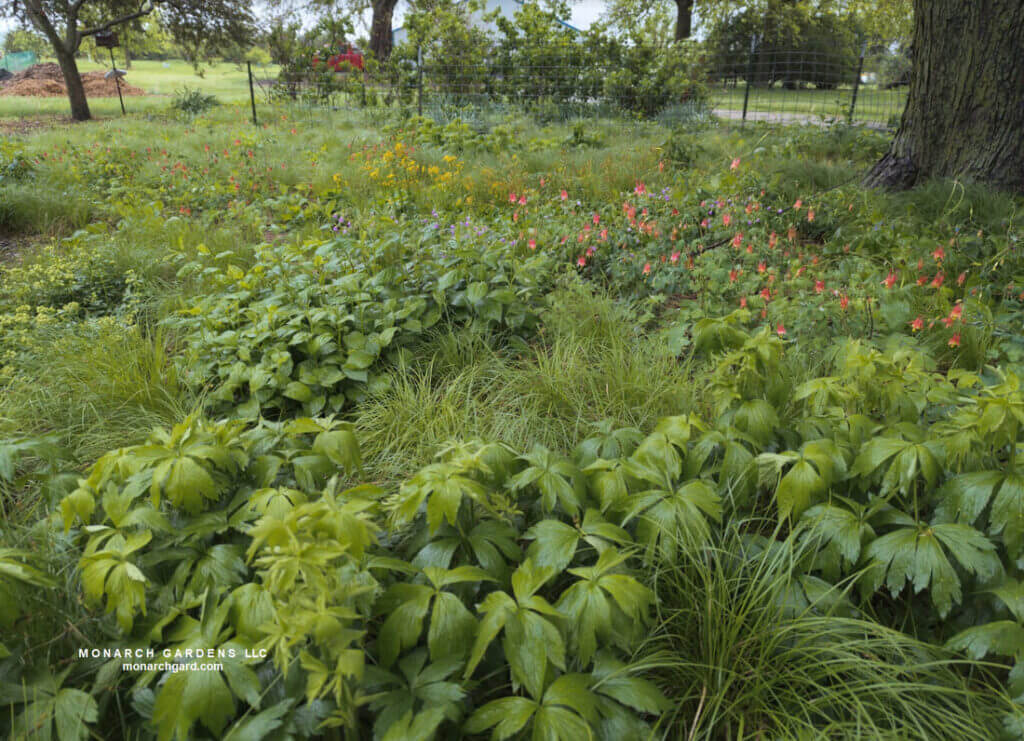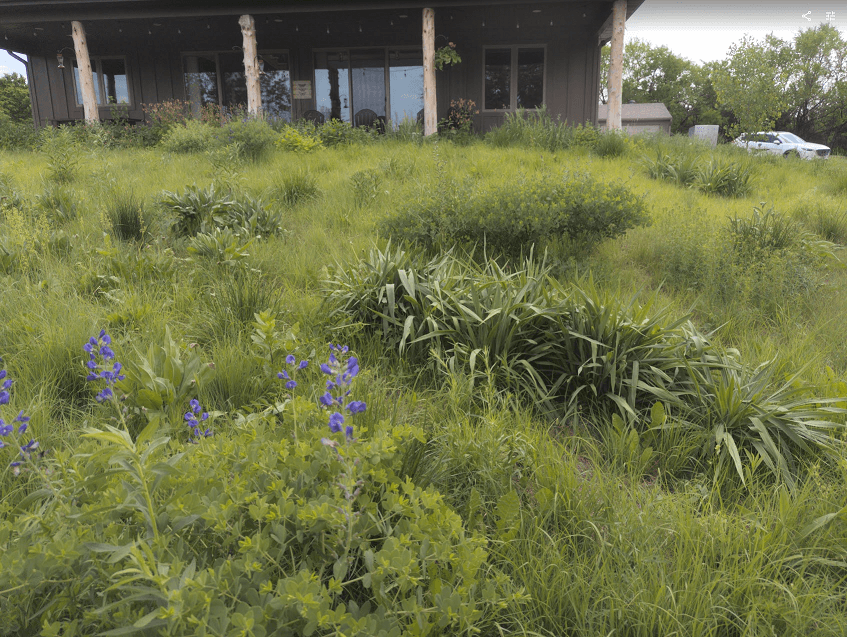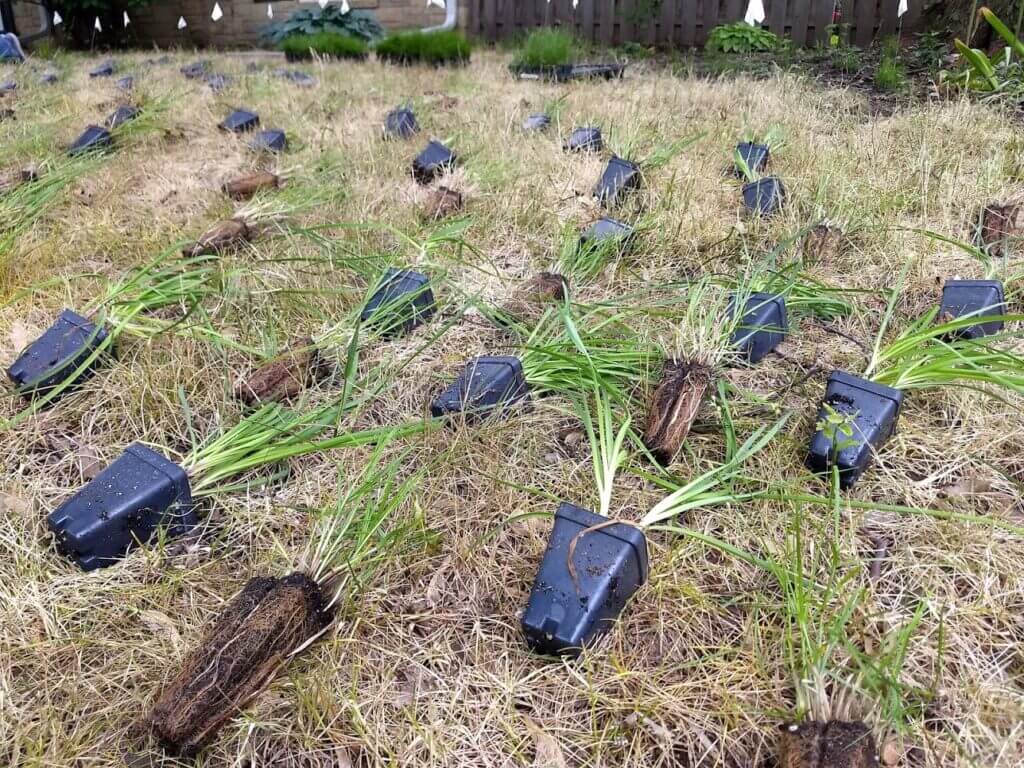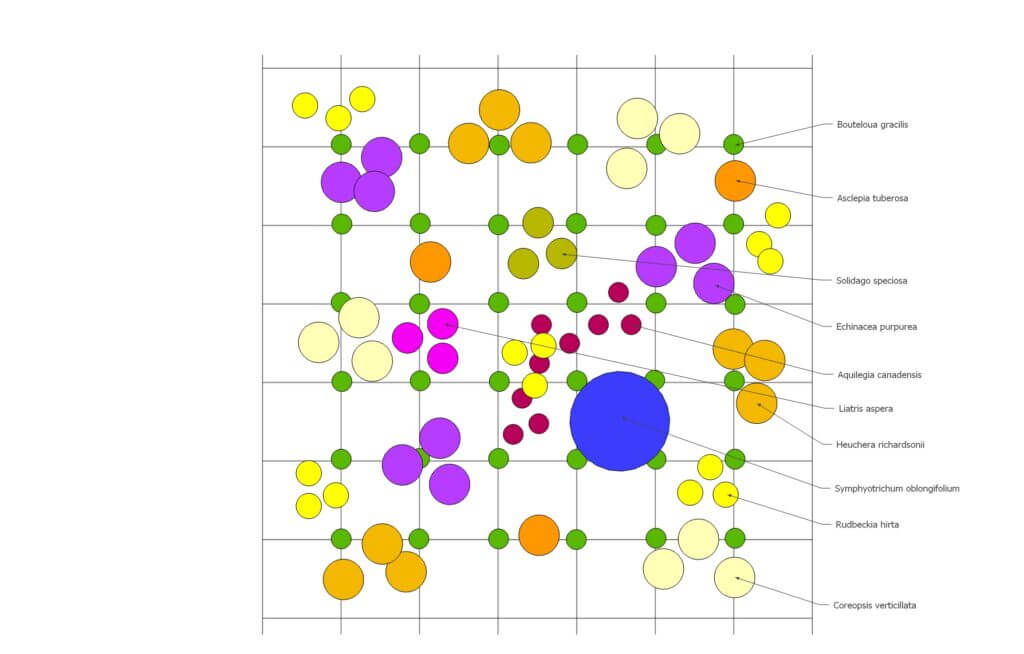Think of it as a lumberjack shirt or gingham curtain (sedge or grasses) overlaid with a repeating paisley print (masses and drifts of flowers).
If you’re new to natural garden design and want to show intention while still having a wilder, climate-resilient landscape, the matrix is it. Plus, honestly, it’s just really darn accessible and actionable no matter if you’re creating a shade meadow or sunny prairie echo.
Matrix garden design begins with the living green mulch or what many refer to as the matrix itself: a groundcover of bunchgrasses and / or sedge placed about every 12 inches on a grid pattern. Over time, these plants will self sow and fill in, even into the very thin (1-2”) of wood mulch you likely spread before installing plants to help mitigate annual weeds the first 1-2 years. While most grass species will be best-suited to sun, there are sedge species that do well in either shade or sun – you’ll need to research species that do best in your specific site conditions and ecoregion / zipcode (not USDA hardiness zone).
The matrix level is composed of one or a few species, which has the benefit of keeping things simple for you and replicating a calm, unifying base color that ties the space together. This is one reason why lawn is so appealing – it has one green hue that soothes and knits landscapes together (it was once thought of as a democratizer by having everyone on an even playing field that created a large suburban park).
[pictured right: matrix of Carex albicans and C. pensylvanica] + [Spaceballs reference above]

Amongst the living green mulch / matrix of grass and sedge you’ll place repeating masses and drifts of flowers that bloom at different periods throughout the growing season. This is the start of your climate-resilient plant community. You’ll want to pay special attention to having bloom succession, which means as one flower species finishes up, another comes online spring through fall.
In general – but certainly for smaller spaces – you’re best advised to have no more than 1-3 flower species in bloom at one time; the benefit here is not to overwhelm the onlooker, especially if this is a yard conversion. Another strategy is to keep all plants are or near a uniform height of roughly 24 inches, give or take half a foot.
Also, smaller spaces usually work best with plant species that have a lower sociability rating – in other words, they do not put out a lot of root runners or seed that germinates easily. Paying attention to how plants reproduce will save you management headaches down the road.
[pictured left: matrix sun meadow] + [Matrix film reference above]

1) Site Analysis – Know how water flows through the space, where snow gathers, length and type of sunlight or shade at various times of the growing season, soil type and drainage, and catalog current vegetation including plants you want to keep and any weed species that may need control prior to planting.
2) Prep Site – Remove unwanted vegetation, rock mulch, thick wood mulch, and weed barrier fabric. Lawn removal can occur via any one of five methods that have various pros and cons. If using plugs or other containerized plants, put down 1” of wood mulch for a shade garden and 1.5” to 2” of wood mulch for a sunny location. Generally, clay soils should have less mulch than loam, and sand or rocky soils should not have any wood mulch at all.
3) Plant Plugs – Plugs are younger, smaller plants that are far more affordable and easier to dig; they tend to come in trays / flats of 32 and 50 plants. Use a soil knife or mixing drill (not a household drill) with a 3” diameter bit. Mixing drills won’t burn out in clay soil, otherwise, if the soil is loam a standard household drill or soil knife will do fine. We prefer to place the repeating masses and drifts of flower species first (3, 5, 7, 11 of a kind) – starting with the taller, more showier ones and working our way down to short species – then place the matrix / living green mulch last. If some plants are practically touching that’s great. If flowers will crowd out sedge or grass in a few years, that’s ok. The goal is to cover the ground plane ASAP to stabilize the site – something traditional mow and blow design does not do, instead relying on perpetual weeding and herbicide use to maintain plants marooned in oceans of deep mulch that stifles plant community development and sustainable ecosystem function. Water plants before install to hydrate and help with transplant shock.

4) Watering – How often and for how long you water is extremely variable. Factors that go into the math are soil type (sand drains faster and so will need more frequent and longer term watering), weather, ecoregion, and time of year. Generally, autumn installations need less watering than spring. Generally, plugs need watering only for a few weeks after installation. The best thing you can do is make sure you’ve matched plants to the site conditions: soil type, drainage, sunlight / shade. Plugs tend to establish faster than gallons as their young, hungry roots are actively growing and touch the site soil much sooner. In our clay and clay loam soils, we tend to advise clients to water 1-3 times a week for 2-3 weeks depending on shade vs sun and time of year – autumn tends to have more rain and cooler temps; after the first 2-3 weeks we ask clients to ween their plants off free water, maybe going down to 1 time a week for two weeks or even going cold turkey. Believe it or not, sometimes tough love is actually helpful as you kick the kids out of the nest.
5) Weeding – Every install is an act of disturbance, and you never know what’s lurking in the soil even in a formerly-pristine lawn. Usually, weed pressure is in the form of annuals which are not a long-term problem even if they might be unsightly the first year. Why are they unsightly the first year? There may be either a lot of them or, because they are annuals, they grow fast and tall and stick out like a sore thumb. After 1-2 years the few annuals that are left within a dense matrix planting are hard to spot as the native plants have grown taller and thicker while annual seeds have been expended. If your annuals are causing an aesthetic issue, deadhead them – don’t pull as that creates more soil disturbance and brings more weed seed to the surface to germinate. Our biggest annual weed issues come from foxtail, crabgrass, horse or mare’s tail, and prickly lettuce. We are fine with dandelions, as they contribute to the living green mulch / matrix layer. Know your area’s invasive weed list and be sure not to let those establish.

6) Cut Down – Leave the garden standing! Matrix gardens look and do good in winter, providing multiple ecosystem services from habitat to weed control to hydrating soils and slowing urban runoff when soils are frozen. Sedge matrix gardens tend not to need much if any tidying in spring, whereas warm-season-grass-dominated spaces in sun do (in large part to increase sunlight hitting the soil which encourages seed germination so plants fill in sooner). Generally, we advise not cutting down or tidying herbaceous perennial gardens until spring soil temps are stable in the 50s and / or the lawn has needed its first mowing. That is, if you even need to tidy at all.
7) Touch Up – Remember, it’s still a garden. Plants come and go from our lives just like other humans, and gaps may open you’ll want to fill (otherwise nature may do it for you with a musk thistle or something else). We tend to plug these gaps in the fall when it’s easier to see them after the growing season. Over time as you gain experience and knowledge, you will likely add more sedge, grass, and flower species to the living green mulch / matrix layer and experiment with taller flowers with various behavior or sociability. But starting out, keep things simple: in a 100 square foot bed, maybe you only have 10 plant species. You can do a lot with 10 species!
Want to learn even more? Try the online class “Intro to Matrix Design” without having to choose between the red or blue pill.
Or see how a Zoo in Indiana, spurred by volunteers, used Prairie Up to create artful and purposeful habitat.
[pictured right: Bouteloua gracilis matrix ready for flower layers]

